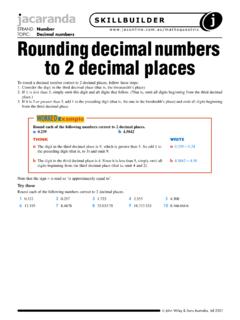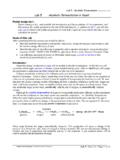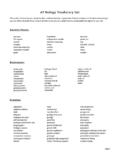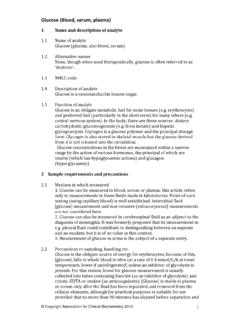Transcription of Anaerobic glycolysis system - Jacaranda
1 68 Live it up 2 Anaerobic glycolysis systemThe Anaerobic glycolysis system also has some alternative names: the lactic acid system or the lactacid system . This system mainly provides the bulk of ATP production during high-intensity, sub-maximal efforts. It may also become the dominant producer of ATP during repeated phosphate efforts which have insufficient recovery time to allow full phosphocreatine replen-ishment. Further, when a performer has gone beyond their maximum oxygen uptake level (their VO max see page 75) during an endurance event, the Anaerobic glycolysis and aerobic systems share the task of creating ATP for the few minutes it will take the performer to stop from exhaustion. In this situation approaching exhaustion, a performer is working at greater than 100 per cent of their maximum oxygen capacity.
2 This is due to the Anaerobic input into the effort. Chapters 5 and 7 will further investigate this Anaerobic glycolysis system operates as the dominant supplier of ATP in the period from around 10 seconds of maximal effort to around 60 seconds of high-intensity sub-maximal effort. Most recent studies suggest that the overlap period when the body switches from using the Anaerobic glycolysis system as the dominant ATP producer to using the aerobic system could start as early as 30 seconds into high-level, sub-maximal Anaerobic glycolysis system is closely linked with several fitness components (see chapter 5): Anaerobic power local muscular endurance speed muscular is classically exemplified in the 400-metre run in secondary school athletics, but it is also highly relevant in a team game when the performer is required to undertake repeated sprints that do not provide sufficient recovery time for the phosphate system .
3 Most players in team games can relate to a situ-ation of having insufficient energy to allow continued top effort, and thus needing a time-out or a rest on the substitution bench. Chapter 4 more fully explains the steps leading to this the 400-metre athletic event, the production of ATP relies on all three energy systems but predominantly on Anaerobic glycolysis . When the athlete pushes off the starting blocks, the phosphate energy system allows for an explosive start to the race. However, this system quickly loses its primary role in ATP production as Anaerobic glycolysis begins to glycogen stores within the muscle are worked on (without the need for oxygen in the muscles) to create ATP, allowing the muscles to continue to propel the body down the back straight of the 400-metre track.
4 The working muscles need ATP at a faster rate than can be adequately provided by the complete breakdown of glucose through aerobic metabolism. Therefore, the pyruvic acid created by Anaerobic glycolysis cannot be processed by oxygen, and it is converted to lactic acid. Hydrogen ions are also released (figure opposite).When lactate and hydrogen ions accumulate in the muscles during high-intensity exercise, muscular contractions are inhibited. The body can tolerate increasing levels of lactate and hydrogen ion production only until their accumulation rate is greater than the body s ability to remove them. The relationship between the rate of lactate production and lactate removal is com-monly identified by the measurement of blood lactate concentration. The term lactate inflection point (LIP) is the preferred term used to describe the stage during incremental exercise where there is a sudden increase in blood lactate concentration (see figure ).
5 Beyond the LIP, exercise intensity (or power output) cannot be maintained for very long and the athlete must reduce or cease their muscular effort. More detail on LIP is provided later in this : Jana Rawlinson (nee Pittman) winning another 400-metre hurdles race. Her effort produces a large amount of lactate and hydrogen ions.











